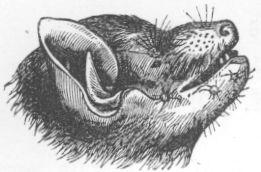| Page 23 | |
|
Natural History of the Mammalia of India and Ceylon - by Robert A. Sterndale F.R.G.S., F.Z.S. (1884)
| |
| prev page next page | contents |
GENUS SCOTOPHILUS.
Muzzle short, bluntly conical, devoid of hair; ears longer than broad; tail shorter than the head and body; wing membrane attached to the base of the toes.
Dentition: Inc., 1—1/6; can., 1—1/1—1; premolars, 1—1/2—2; molars 3—3/3—3.
Jerdon's formula gives upper incisors 4.
92. SCOTOPHILUS FULIGINOSUS., The Smoky Bat (Jerdon's No. 40).
HABITAT.—Central Nepal.
DESCRIPTION (apud Hodgson).—"Feet very small, included in the wing membrane nearly to the end of the toes; ears acutely pointed, shorter than the head; muzzle groved, nudish; face sharp; rostrum somewhat recurved; wholly sooty brown; a little smaller than Vesp. formosa."
I cannot find this bat mentioned by any other author, and Jerdon says it does not seem to be recognised.
 |
| Scotophilus Temminckii |
93. SCOTOPHILUS TEMMINCKII. Syn.—NYCTICEJUS TEMMINCKII (Jerdon).
HABITAT.—India generally; Burmah and Ceylon.
DESCRIPTION.—Ears short, rounded and narrow; tragus narrow, curved and pointed inwards; muzzle thick, blunt and conical; the fur varies, sometimes dark olive brown, fulvous beneath, and occasionally chestnut, with a paler shade of yellow below.
SIZE.—Four and a-half inches, of which the tail is 1˝; expanse, 13.
A very common species, appearing early in the evening. Horsfield says of it that it collects by hundreds in hollow trees, and feeds chiefly on white ants.
94. SCOTOPHILUS HEATHII.
HABITAT.—India and Ceylon (Rajanpore, Punjab).
DESCRIPTION.—Similar to the above, but longer in all its measurements (Dobson). Judging from drawings, the head and muzzle of this are more in a line than in the last species, the ears project forward, and are also larger, the tragus especially, and there is a greater width between the ears.
SIZE.—Five inches, of which the tail is 2.
95. SCOTOPHILUS EMARGINATUS.
HABITAT.—India; precise locality unknown.
DESCRIPTION.—Head broad and flat; muzzle obtuse and thick; ears long and large, with rounded tips turning outwards; tragus short; thumb long with a strong claw; wing membrane quite devoid of hair, except on the interfemoral membrane, which is half covered; fur tricolored, first dark chestnut, buff, and then yellowish brown.
SIZE.—Head and body, 2-1/10 inches; tail, 2 inches.
96. SCOTOPHILUS ORNATUS. Syn.—NYCTICEJUS ORNATUS.
HABITAT.—India and Burmah.
DESCRIPTION.—Head broad; muzzle short; ears triangular, erect, with rounded tips, and broadly rounded lobe at the base; tragus narrow, semi-lunate, curved towards the front; fur a light Isabelline brown, spotted with white; a white spot on the centre of the forehead, and from the back of the head down the spine for two-thirds of its length a narrow white streak; on each side of the body two white patches; a broad white collar, or rather demi-collar, from one ear spot to the other, passing under the throat. Dr. Dobson says the position of these patches is very constant, but the size varies, being greatest in individuals of a pale rusty red colour, and these he found always to be males.
SIZE.—Head and body, 3 inches; tail, 2 inches; expanse, 15.
97. SCOTOPHILUS PALLIDUS.
HABITAT.—Mian Mir, Lahore.
DESCRIPTION.—Head and muzzle as in S. Temminckii; ears slightly shorter than the head; internal basal lobe convex, evenly rounded; tip broadly rounded off; tragus moderately long and rounded at the tip; a prominent triangular lobe at base. Wing membrane from base of toes; lobule at the heel very narrow and long; last rudimentary caudal vertebra free; fur of the body, wings, and interfemoral membrane pale buff throughout.
SIZE.—Head and body, 2 inches; tail, 1·4 inch.
NOCTULINIA NOCTULA.
(See ante: Vesperugo noctula—Jerdon's No. 41.)
NYCTICEJUS HEATHII. Large Yellow Bat (Jerdon's No. 42).
(See ante: Scotophilus Heathii.)
NYCTICEJUS LUTEUS. The Bengal Yellow Bat (Jerdon's No. 43).
NYCTICEJUS TEMMINCKII. The Common Yellow Bat (Jerdon's No. 44).
Both the above (Nos. 43 and 44) are, according to Dr. Dobson, synonymous with Scotophilus Temminckii, which see.
NYCTICEJUS CASTANEUS. The Chestnut Bat (Jerdon's No. 45).
This is also a variety of Scotophilus Temminckii.
NYCTICEJUS ATRATUS. The Sombre Bat (Jerdon's No. 46).
(See ante: Vesperugo atratus.)
NYCTICEJUS CANUS. The Hoary Bat (Jerdon's No. 47).
(See ante: Vesperugo lobatus.)
NYCTICEJUS ORNATUS. The Harlequin Bat (Jerdon's No. 48).
(See ante: Scotophilus ornatus.)
98. NYCTICEJUS NIVICOLUS. The Alpine Bat (Jerdon's No. 49).
HABITAT.—Sikim.
DESCRIPTION.—"Head and body above uniform light brown with a slight yellowish shade; underneath, from the throat to the vent, dark grey with a brownish tint, lighter on the sides of the throat. Ears long, attenuated to an obtuse point."—Jerdon.
SIZE.—Head and body, 3 inches; tail, 2 inches; expanse, 19 inches.
This bat was described by Hodgson ('Ann. Mag. Nat. Hist.' 1855), but there is
some doubt about it, and it has been classed as a Lasiurus and also with Scot.
ornatus and Vesp. formosa, but Jerdon thinks it a distinct species. I cannot find any mention of it in Dobson's monograph.
